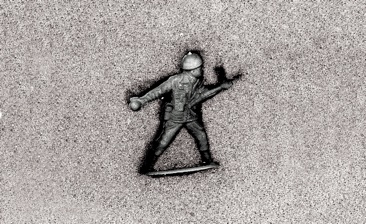mimicry (2010) __
the shaman (2009) __
sieg und niederlage (2008-10) __
expansion der gegenwart (2009) __
brigade joussance (2004) __
spaßkulturen (1997) __
international fuel crisis (2007-2010) __
kunst des nationalismus (2006) __
unkirche (2007) __
widerlegung der unterhaltung (1998) __
traktat über die schlange (1998) __
turns (2001-2009)
* Art & Research – Artists do not conduct scientific research. They may imitate scientific behaviour or standardisation and may apply scientific tools and methods. They also may aquire a scholar language to justify specific works that are technological in nature and thus may suggest that their design is driven by a strive to understand nature or the order of things. But it is all fake. Do not buy it. Art does not give a damn about non-art. And artists are entrepeneurs that could not care less about any subject – whether aesthetic, social, political, historical, or formal – that they are willing to use for their purposes. They are basically tyrants and snobs, and probably they need to be (some, however, take this task too literally and turn into lifestyle zombies).
Once we recognise this, we are likely to free ourselves from certain pre-conceptions about what functions art has to fulfill in society, and we discover that the artistic endeavour is analogous to conducting research, albeit not in a scientific way. In his aesthetic theory Adorno has emphasized repeatedly that it is not the narrative or the form that connects art with society but what he called ‘Gehalt’ = content (including form & narration/storia). Any aesthetic that deals with art therefor implicitly deals with research in relation to specific fields in society, be it politics, be it science. In the Renaissance this connection was much more vivid and detectable – if we think of Brunelleschi’s famous mirror experiment in front of the Baptistery in Florence in 1425.
art & research*
Lasst euch nicht verführen!
Es gibt keine Wiederkehr.
Der Tag steht in den Türen;
Ihr könnt schon Nachtwind spüren:
Es kommt kein Morgen mehr.
Lasst euch nicht betrügen!
Das Leben wenig ist.
Schlürft es in schnellen Zügen!
Es wird euch nicht genügen
Wenn ihr es lassen müsst!
Lasst euch nicht vertrösten!
Ihr habt nicht zu viel Zeit!
Lasst Moder den Erlösten!
Das Leben ist am größten:
Es steht nicht mehr bereit.
Lasst euch nicht verführen
Zu Fron und Ausgezehr!
Was kann euch Angst noch rühren?
Ihr sterbt mit allen Tieren
Und es kommt nichts hinterher.
* Text: Bertolt Brecht, Gegen Verführung, Hauspostille, Berlin 1926
* Today, people fall for the fake gesture (the socially concerned artist, the techno-geek art expert, the science driven art guy etc.) and totally mis-represent any meaningful implementation of art practice in their daily lives. The fake gesture is legitimate, but it is illegitimate – on the side of the recipient – to fall for it like a believer. Art believers. No matter what they are going to tell you, artists do not believe in art – genuinely – because they are producing it permanently. They are like a TV–soap opera producer that would never believe in the clichee of the rich and the famous that he projects on stage. In short: research must deal with the in-between, forms and methods that yet need to be defined or discussed, lacking any belief in the form or in the narration (if possible, but it is impossible – but, still!), lacking the belief in art or in politics or in science or in history or...Theologicians imply (by the self-definition of the discipline) that the Divine is a given subject matter that has to be dealt with. Similarly, many literary and art critics or historians approach the arts: as a given subject. However, this is the opposite of what any idea of research could possibly mean: if you want to speak about art, literature etc. there are no given subjects, you have to make it up, there is no given-ness, since there was none in the production of the work. Thus, many art critics and culture experts are nothing but theologicians in the field of culture. They defend and archive their subject matter (I believe Hans Haacke called this the ‘art syndrome’). But there is no subject matter, “you idiots”! – to quote Inspector Clousseau, the ultimate artist, as he succeeds where no one would expect him to.
art believers*
Don’t allow yourself to be seduced!
There will be no return.
The day is in the doorway;
You can already sense the night winds
Mornings will come no more.
Don’t let yourselves be tricked,
Life is scarce.
Sip it to the fullest,
It will not suffice to you
When you have to let it go.
Don’t let yourselves be put off!
You don’t have too much time!
Let the redeemed rot in their graves!
Life is the greatest:
It is not for us anymore.
Don’t allow yourselves to be seduced
to drudgery and emaciation!
Can fear tremble you anymore?
You die with all animals
And there is no after.
* Text: Bertolt Brecht, Against Seduction,
Manual of Piety, Berlin 1926 [transl. NN]
gegen verführung/against seduction*

In einem Artikel der FAZ zum Band ‘Krieg und Kunst’ (2002), in dem ich einen Beitrag verfasst hatte, wurde ich als “Halbkünstler” beschrieben. Damit sollte zum Ausdruck gebracht werden, dass ich, von der Bildenden Kunst kommend, als Autor im Wissenschaftsbetrieb tätig wurde d.h. weder als Kunst-Fisch, noch als Wissenschafts-Fleisch durchging. Aber dies ist nur die halbe Wahrheit, denn gerade um das Halbkünstlertum geht es, das gegen die Vollkünstler und Nicht-Künstler aller Coleur agitiert – nicht zwischen, sondern unter und auf den Stühlen, Tischen und allem sonstigen Möbilar des Kulturbetriebs, dem es gerade diese seine ‘Kultur’ austreiben möchte.
halbkunst*